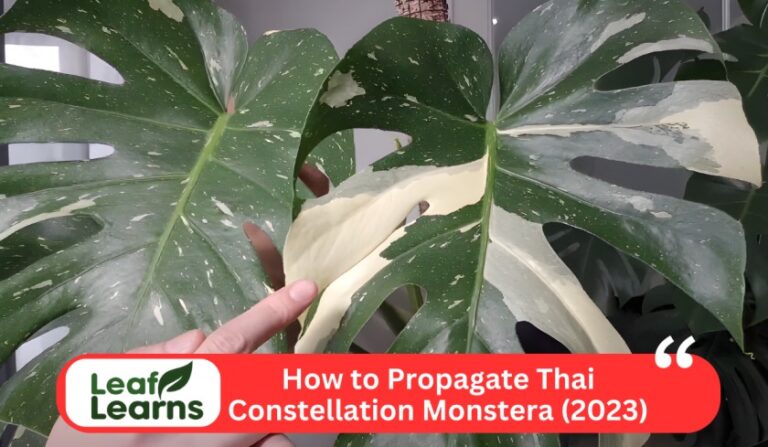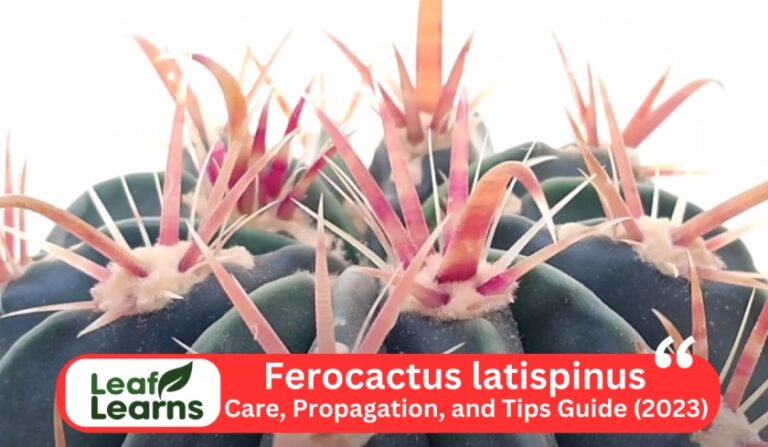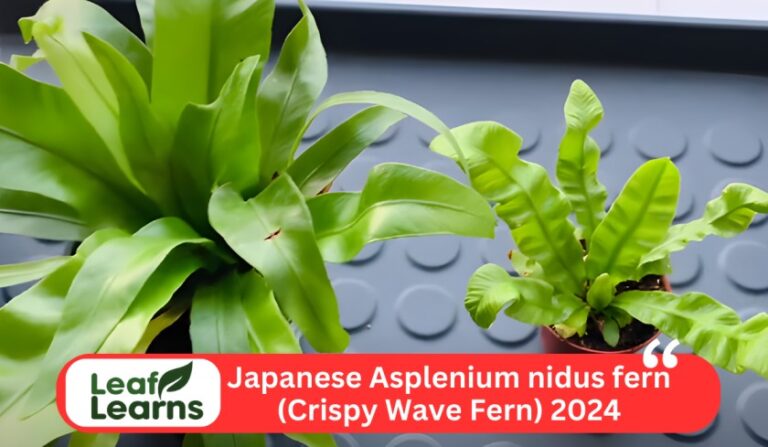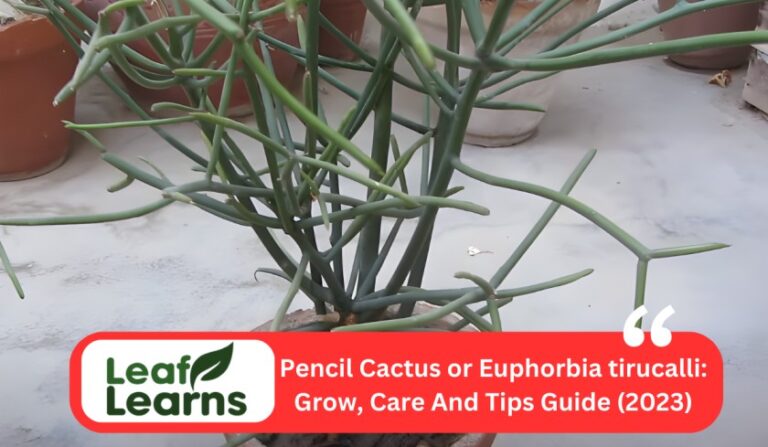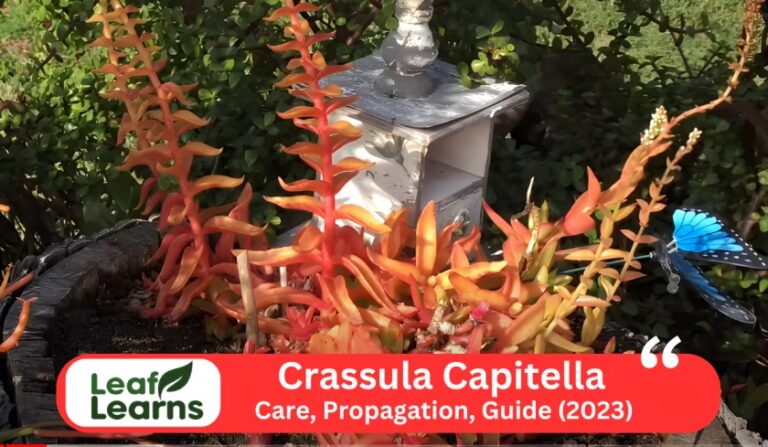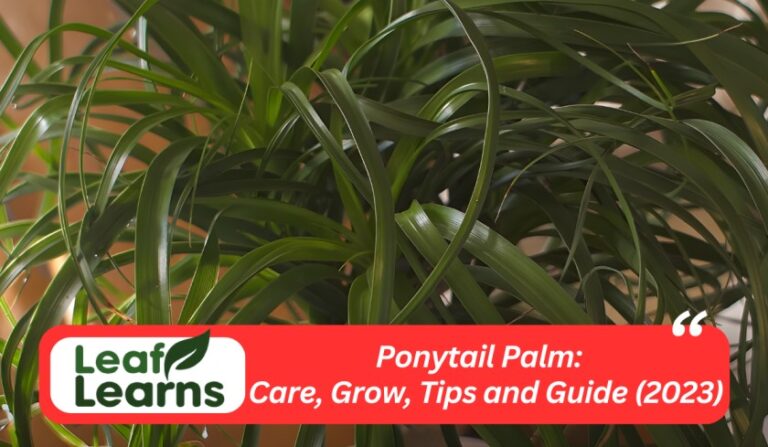Peperomia Ferreyrae/Pincushion Peperomia Care Guide (2023)
The Peperomia Ferreyrae, which is also referred to as the ‘Happy Bean’, is an adorable succulent perennial plant that originates from Peru. Being a member of Piperaceae family and owing to its bright green leaves and compact size, it is widely grown as an indoor decoration.
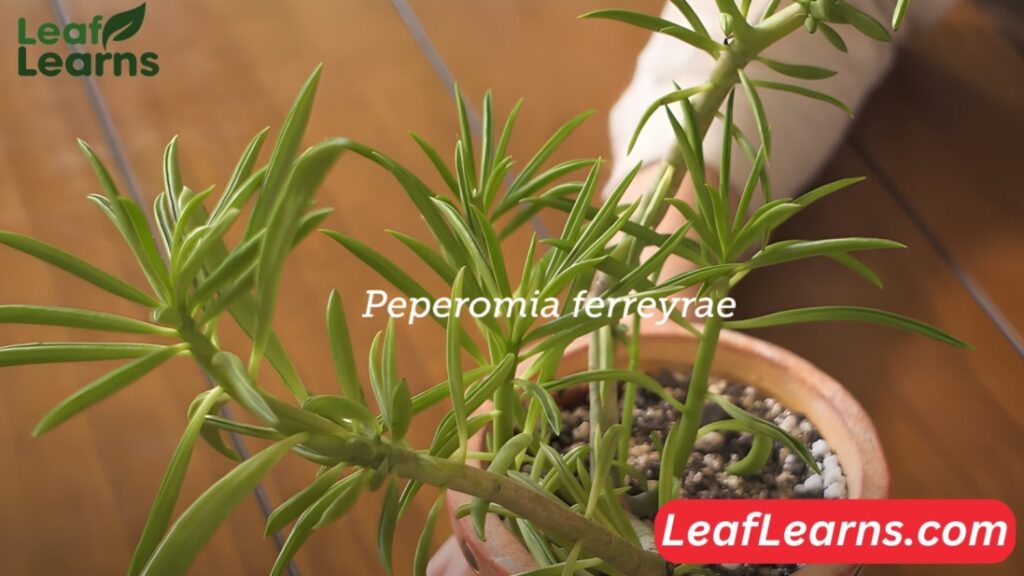
This resilient beauty survives in good draining soil and average light, displaying inconsequential greenish-white flowers.
Contents
- 1 What’s Unique About Peperomia Ferreyrae?
- 2 Peperomia Ferreyrae Care
- 3 Repotting
- 4 Peperomia Ferreyrae Propagation
- 5 Growing Problems
- 6 Peperomia Ferreyrae Pruning
- 7 How to Get Peperomia Ferreyrae to Bloom
- 8 Growth Rate and Size
- 9 Peperomia Ferreyrae Flower
- 10 Foliage of Peperomia Ferreyrae
- 11 Appearance
- 12 Fragrance
- 13 Common Pests and Diseases
- 14 Problems and Solutions
- 15 Toxicity
- 16 Peperomia Ferreyrae toxic to cats
- 17 Varieties/Types
- 18 Uses
- 19 Maintenance of Pincushion Peperomia: Nurturing the ‘Happy Bean’
- 20 Issues, and Safety: Ensuring the Well-being of Pincushion Peperomia
- 21 FAQs
What’s Unique About Peperomia Ferreyrae?
This makes Peperomia Ferreyrae very distinguished due to its enchanting look. The ‘Happy Bean’ is so called due to its delicious, bean-shaped leaves that form a beautiful cascading effect.
Its small size and the fact that it grows well in indirect light, allowing for its growth in many indoor areas.
This plant’s unique qualities make it a good choice for individuals who are looking to get a visually pleasing, low-maintenance member of their indoor collection of plants.
As a non-toxic product, it spreads joy without sacrifice and creates an auspicious environment for homes and offices.
| Common Name | Pincushion Peperomia, Bean Plant |
| Scientific Name | Peperomia Ferreyrae |
| Family | Piperaceae |
| Origin | Peru |
| Plant Type | Succulent, Perennial |
| Size | 6-12 inches (height), 6-8 inches (width) |
| Lifespan | Perennial |
| Leaf Colour | Green |
| Leaf Size | 3 inches long |
| Flower | Insignificant, Greenish-White |
| Light | Bright, Indirect Light |
| Water | Moderate, Allow Soil to Dry Between Watering |
| Soil | Well-Draining, Peat-Based Mix |
| Temperature | 65-75°F (18-24°C) |
| Humidity | Moderate to High |
| USDA Zone | 10-12 |
| Fertilizer | Balanced, Diluted Monthly During Growing Season |
| Propagation | Leaf Cuttings, Stem Cuttings, Division |
| Pruning | Trim Leggy Growth, Remove Yellowed Leaves |
| Pests | Spider Mites, Mealybugs, Aphids |
| Toxicity | Non-toxic, Safe for Pets |
| Uses | Indoor Ornamental Plant, Houseplant |

Peperomia Ferreyrae Care
Light Requirement
The world of Peperomia-Ferreyrae is filled with vigor where the ‘Happy Bean,’ a fantastic succulent, loves bright, indirect lighting.
Provide it with filtered light during the summer to protect it from searing rays so that its diminutive size stays lively.
During winter, the need for moderate light that can grasp its resilient nature is enough.
By spring and fall, ensure the fine equilibrium for constant growth. 6-12 inches is the preferred height of this flexible plant, which means it can decorate any space with grace.
This light-loving plant is the perfect option for both beginners and professionals in plants.
Peperomia Ferreyrae Watering Requirements
Think “thirsty, but not desperate.” This cute succulent likes to have time to dry between watering, so do not immerse it twice a day. Here’s how to navigate the watering seasons:
Summer: Hotter days mean increased thirst. Water once per week, deeply and allow the water to drain from the bottom of the pot.
As a reminder, dry leaves are a call for help, but too much moisture causes root rot; it is better to be on the side of dry.
Winter: With shortening days and falling temperatures your Happy Bean’s metabolism rate also decreases. Cut down watering frequency to once every 2-3 weeks and allow the soil to dry completely before giving it another sip. Overwatering in the winter is a disaster waiting to happen, so pay attention to the quiet periods between waterings.
Spring: Spring is a time for rebirth, and even the Happy Bean may flower with small white blossoms! Slightly more often than in the winter, every 10-14 days water.
Fall Foliage: When temperatures become cool again, return to the once every 2 weeks watering regimen. Keep in mind that the pot size and soil drainage as well matter.
A clay or terracotta pot with soil that drains will dry faster than a plastic pot with denser, drier soil.
Peperomia Ferreyrae Soil Requirement
Think drainage, Stay away from heavy, moisture-loving mixes; soggy soil is a party pooper. Imagine light, airy, drainable soil – like a well-ventilated beach party for roots. A cactus or succulent mix is a great base, Or make your own blend using peat moss, perlite and coarse sand.
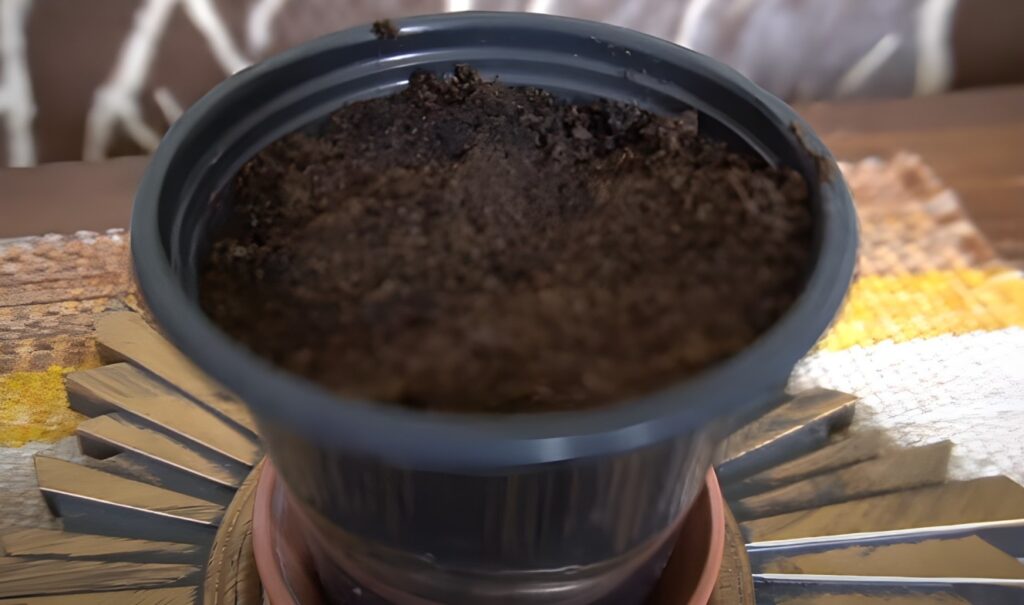
Summer: As temperatures increase, the party begins to get hot. Keep the soil dry between periods of watering to prevent a rooty collapse.
Winter: The tempo slows down. The soil has to be slightly moist, but never wet. Don’t sink the party during cold months!
Spring and Fall: They are the in-betweens where the groove of soil gets its equilibrium. When the top inch feels dry, water it and your Happy Bean will continue to swing its leaves happily.
Temperature Requirement
In order to grow, the ideal climate for your Happy Bean is important. Cultivate a temperature range of 65-75°F (18-24°C) during the summer season.
As winter comes close, set up a slightly less warm environment say around 60-70°F (15-21°C) to allow the plant rest period. Adjust to the changing seasons in spring and fall by maintaining a constant temperature.
Humidity Requirement
Summer: Think steamy jungle mornings. 50-60% humidity – a pebble tray under your bean or perhaps a couple of quick misting every week. Do not blast your air conditioners, as dry air can cause the curling of its leaves.
Winter: Imagine a snug little cabin with just a wisp of smoke from the chimney. 40-50% humidity is ideal. Wonders have been known to be achieved by grouping your Happy Bean with other plants loving humidity or placing it close to a humidifier.
Spring and Fall: Picture dewy mornings and chilly evenings. These seasons provide natural humidity variations your bean loves. But watch out for dry spells and compensate with misting or grouped plants.
Fertilizer Requirement
Add a well-planned and balanced fertilizer routine to improve the appeal of your the ‘Happy Bean’. Provide the plant with a diluted, well-balanced liquid fertilizer monthly during its active development season in summer.
Reduce feeding throughout the winter when the plant becomes dormant and has minimal requirements for support in nutrients.
As spring arrives, start feeding again normally and follow this regimen into fall. Use a fertilizer that contains all the necessary micronutrients to improve leaf color and overall health.
A professional-grade and well-diluted fertilizer will keep your Pincushion Peperomia looking healthy with bright green leaves, while maintaining a compact shape that makes for an appealing setting indoors.
Potting Requirement
Choose a pot with drainage holes for your Pincushion Peperomia to avoid waterlogging and allow the water to flow out freely. Use a potting mix which conducts water well preferably a mixture of peat.
Happy Bean’ prefers relative crowding, so select a pot that comfortably fits its tight dimensions. Once the potting begins, carefully take out the plant from its current container without harming its roots.
Repotting
Peperomia-Ferreyrae rarely needs repotting. To determine if the plant is becoming root-bound you should repot every 2 years.
Repotting is best done in spring or early summer, as the plants are beginning rapid growth. Choose a pot that can accommodate some growth but not too big.
When repotting, take care to loosen the roots gently and cut off any that are rotten or dead. Re-pot using a well-draining potting mix.
After repotting, give the plant time to adapt and resume normal care regimens. With this type of potting and repotting regime, the Pincushion Peperomia remains a lively and healthy specimen with all its green glamour.
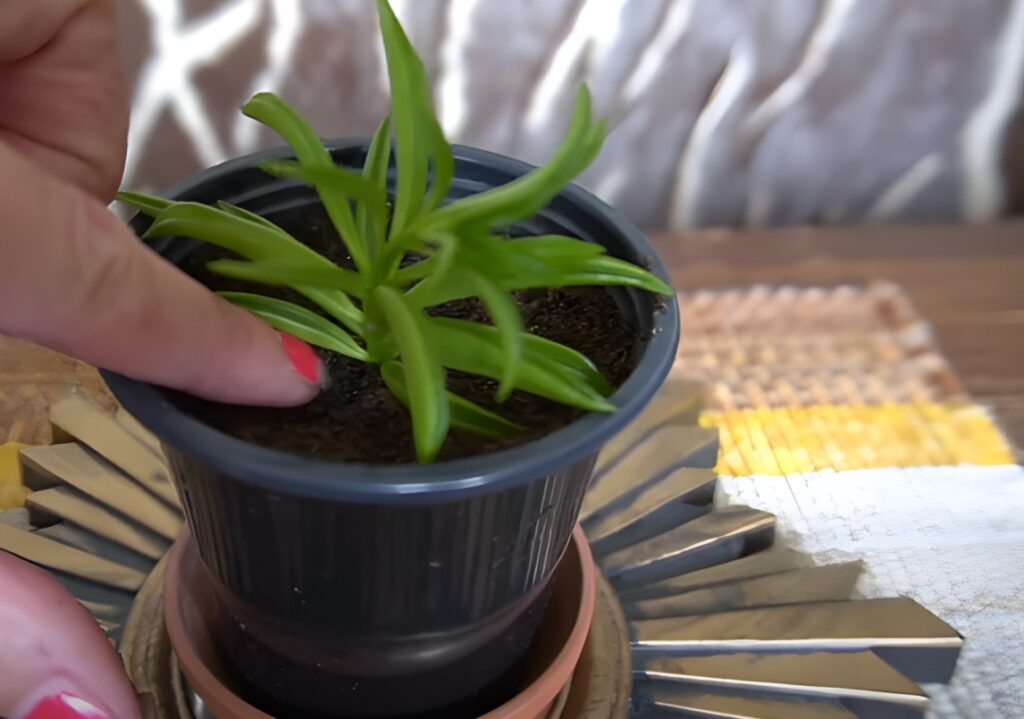
Peperomia Ferreyrae Propagation
- There is a new opportunity for any plant enthusiast to propogate and share the joy of happy bean plant “ Here’s a step-by-step guide:
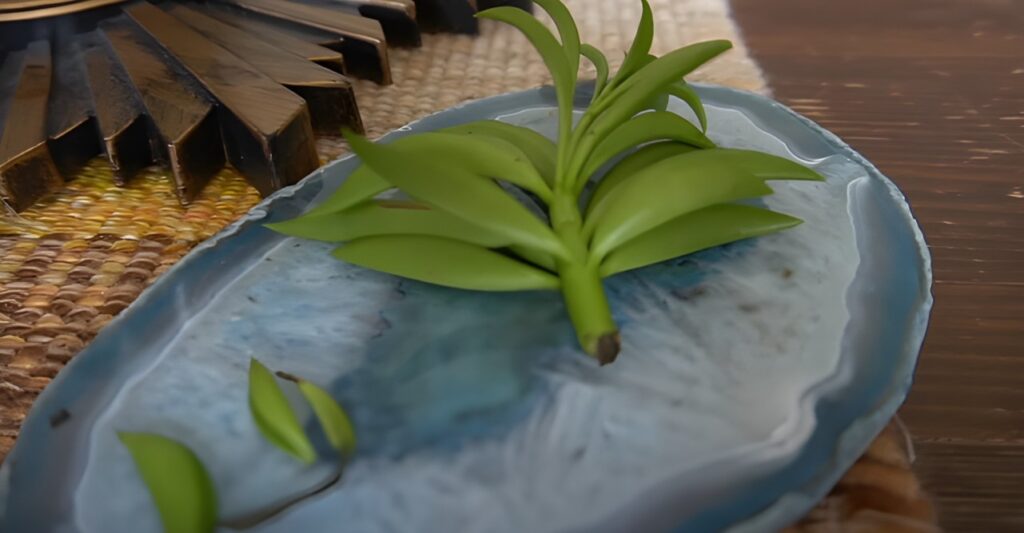
- Select Healthy Plant
- Start with a grown-up healthy Pincushion Peperomia. Healthy stems with at least a few leaves are preferable.
- Choose Propagation Method
- Propagation of Peperomia Ferreyrae can be done through leaf and stem cuttings. Choose which method you want to use.
- Leaf Cuttings
- Take a healthy leaf out of the plant and make sure to have part of the stem attached to it. Allow it to air dry for an entire day so a callus can form.
- Stem Cuttings
- Cut a fresh stem with several leaves, but make sure it is at least few inches long. Allow it to dry for a day.
- Planting
- Transplant the dried cuttings to a well-draining mix and bury the end that was cut. Mist the soil lightly.
- Provide Adequate Light
- Place the cuttings in bright, indirect light to promote rooting.
- Maintain Moisture
- Ensure the soil remains moist all through until roots establish themselves.
- Transplanting
- When the roots are established, transfer the Pincushion Peperomia into its final place.
Growing Problems
- Leaf Issues
- Yellowing: Ensure proper light exposure and adjust watering to prevent overwatering or underwatering.
- Black Tips/Edges: Maintain humidity levels and avoid excessive direct sunlight.
- Legginess
- Trim leggy stems to encourage bushier growth.
- Provide adequate sunlight to prevent stretching.
- Dropping Leaves
- Check soil moisture, avoiding waterlogging.
- Assess environmental conditions for temperature and humidity changes.
- Pests
- Watch for spider mites, mealybugs, or aphids.
- Use insecticidal soap for a natural remedy.
- Root Rot
- Ensure well-draining soil and adjust watering frequency.
- Remove affected parts promptly.
Peperomia Ferreyrae Pruning
To promote a dense Bushy shape trim leggy growth and remove yellowed leaves. Thus, this process not only increases its visual appeal but also contributes to healthier foliage.
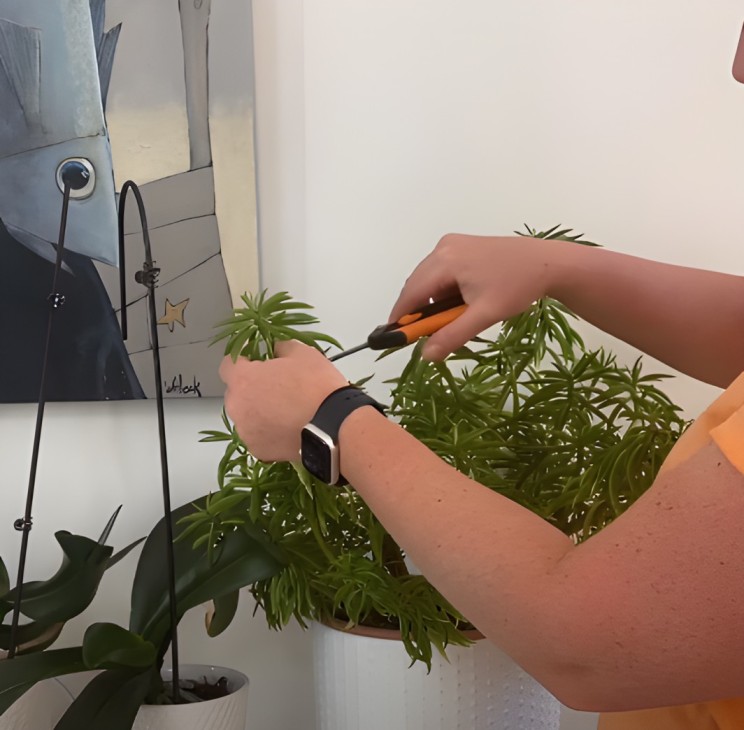
Use clean, sharp scissors or pruning shears for accuracy. Pruning on a regular basis helps to control the size and shape of the plant making it an ideal piece for any indoor space.
| Pruning Steps | Trim leggy growth, remove yellowed leaves |
| Tools Needed | Clean, sharp scissors or pruning shears |
| Frequency | Regular pruning, as needed for maintenance |
| Purpose | Enhance aesthetic appeal, control size and shape |
| Benefits | Promotes bushier growth, healthier foliage |
| Result | Compact, visually appealing Pincushion Peperomia |
How to Get Peperomia Ferreyrae to Bloom
Provide Adequate Light: Provide your Pincushion Peperomia with bright, indirect light so it is like the conditions in its native environment.
Optimal Temperature: Keep the temperature between 65 – 75°F (18-24°C) for optimum growth and flowering.
Balanced Fertilization: feed your plant with a balanced, diluted fertilizer every month during the growing season.
Proper Watering: Do moderate watering, so that the soil dries just a little between irrigations to avoid overwatering.
Healthy Soil: This will ensure that the roots are highly aerated.
Regular Pruning: Trim leggy growth to promote bushiness and direct energy towards flowering.
Growth Rate and Size
Moderate Growth: The Peperomia-Ferreyrae grows steadily and it is a manageable and rewarding plant with an enthusiast.
Compact Size: 6-12 inches and a width of 6-8 inches makes it an excellent pick for individuals looking for small indoor plants.
Perfect for Indoors: Due to its small size, it can fit into most indoor spaces and add a bit of green without cluttering the area.
Peperomia Ferreyrae Flower
Delicate, narrow spikes rise from the base of the plant bearing small yellow flowers that appear like tiny candles lit within emerald leaves. They are not overly flashy, but they add a bit of playful and bursts of brightness to the overall appearance.
Foliage of Peperomia Ferreyrae
Shape: Picture an array of green beans, neatly tucked around juicy meaty stems in spirals. These are not just normal beans; each leaf is shaped like a plump, elongated and pointed pod or a feather of peacocks.
They mature at lengths of 3 inches and drape smoothly downward, giving a playful yet sophisticated waterfall-like appearance.
Color: Happy Bean is a bright lime green which lights up any room for a spark of freshness. Each leaf shows a prominent darker green stripe flowing down the center of each leaf, slightly resembling a tiny emerald vein adding depth and enhancing visual interest.
Appearance
Vibrant Greenery: Peperomia-Ferreyrae , affectionately known as the ‘Happy Bean’, this plant features extremely lively green, kidney-shaped leaves that hang gracefully.
Compact Size: This delightful plant usually reaches manageable heights of 6-12 inches, so it is suitable for any indoor setting.
Distinctive Features: It produces a distinctive look because of its unique, succulent leaves that give it an attractive cascading effect.
Delightful Cascading Effect: The name for the ‘Happy Bean’ arises from ihe delightful cascading arrangement of its tiny, edible leaves.
Fragrance
While many houseplants lack fragrance, the Happy Bean has a gentle but pleasant scent. Imagine a light, sweet aroma like that of newly minted peas or freshly mowed grass.
Common Pests and Diseases
Pests
- Spider Mites: Keep an eye for fine webbing and tiny pests under leaves.
- Mealybugs: Check for cotton-like clusters on leaves and stems.
- Aphids: Watch for small, sap-sucking insects on new growth.
Diseases
- Root Rot: Avoid overwatering to prevent this fungal disease.
- Yellowing Leaves: Could indicate both overwatering or underwatering; assess soil moisture.
- Leaf Spot: Maintain good air circulation to reduce the risk of fungal infections.
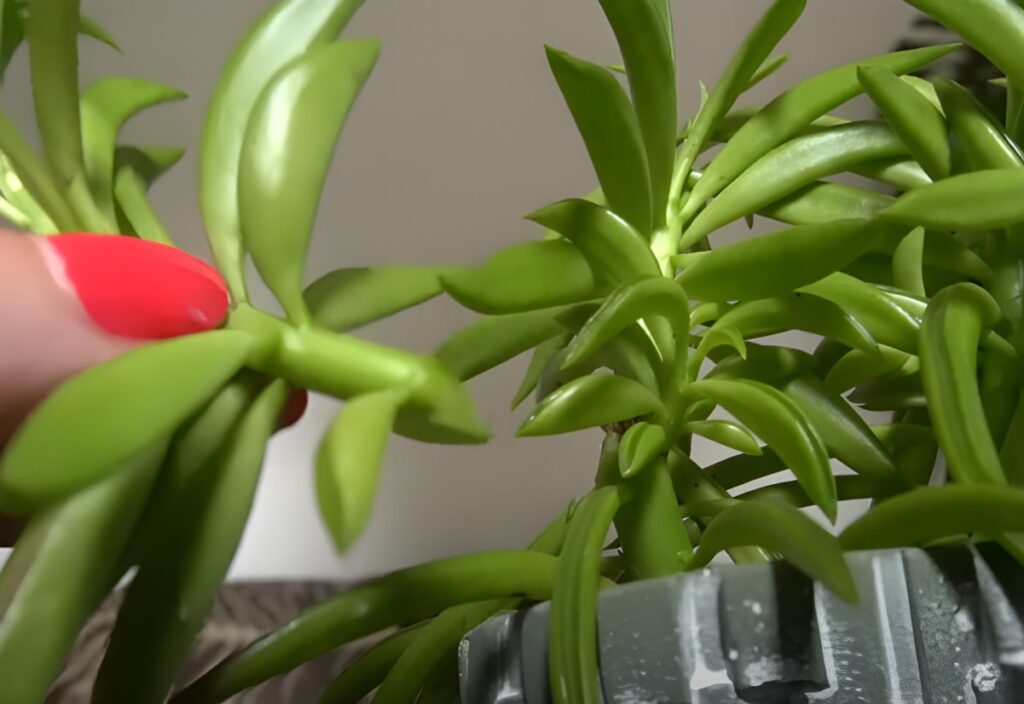
Problems and Solutions
Problem: Yellow Leaves
Solution: Assess soil moisture content and modify watering schedule to avoid overwatering..
Problem: Leggy Growth
Solution: Put the plant in a brighter area and trim any lanky stems to promote bushier growth.
Problem: Root Rot
Solution: Make sure the soil drains properly, and water less frequently to avoid soggy roots.
Problem: Peperomia Ferreyrae leaves falling off
Solution: Assess the lighting and make necessary adjustments to give happy bean plant the right amount of light.
Problem: Mealybugs or Aphids
Solution: Apply a solution of water and gentle soap; if need, eliminate bugs by hand.
Problem: Yellowing in Winter
Solution: Reduce watering during the dormant season and let the soil somewhat dry between applications..
Toxicity
The ‘Happy Bean, is a popular indoor plant that is safe and non-toxic to humans, which makes it a great option for households. Its vibrant green leaves are happy without endangering people.
Take pleasure in the lively splendour of the “Happy Bean” without worrying about its health effects as it brings a little bit of nature into your interior spaces.
Peperomia Ferreyrae toxic to cats
Pet owners can rejoice as Peperomia Ferreyrae is not toxic to cats or dogs! Pets can safely use Pincushion Peperomia since it poses no toxicity risk to dogs or cats. So it can be edible.
Varieties/Types
Peperomia-Ferreyrae
- Happy Bean Original This cultivar adds a whimsical touch to any area with its recognisable brilliant green, fleshy leaves with the prominent middle stripe.
Peperomia-Ferreyrae ‘Variegata’
- With its creamy white variegation adorning the margins of its bean-shaped leaves, this variety lends a touch of refinement. It like a smattering of moonlight on a lush painting.
Peperomia-Ferreyrae ‘Red Margin’
- The feisty personality of this Happy Bean is amazing! Its vivid red-edged leaves give your indoor jungle a dramatic splash of colour.
Peperomia-Ferreyrae ‘Musifolia’
- Like your beans a little plumper? With its shorter, thicker leaves that curl inward, this cultivar has a fuller, more compact appearance.
Peperomia-Ferreyrae ‘Marble’
- This contented bean enjoys experimenting with designs! With lighter green base and darker green veins running over them, its leaves have an eye-catching marbled look.
Uses
- Indoor Ornament: The ‘Happy Bean,’ a visually pleasing and small ornamental plant, will elevate interior aesthetics.
- Air Purifier: By naturally removing pollutants from the air, Peperomia-Ferreyrae helps to enhance the quality of the air inside.
- Low-Maintenance: Suitable for both inexperienced and seasoned plant lovers, this plant is low-maintenance and perfect for people with hectic schedules.
- Non-Toxic: Provides pet owners with piece of mind by being safe and pet-friendly in homes with furry friends.
- tension Reliever: It has been demonstrated that greenery reduces tension, and the “Happy Bean” brings a peaceful element to any area.
- Adaptable Interior Design: It may be used as an adaptable décor piece in a variety of design styles due to its small size and distinctive bean-shaped leaves.
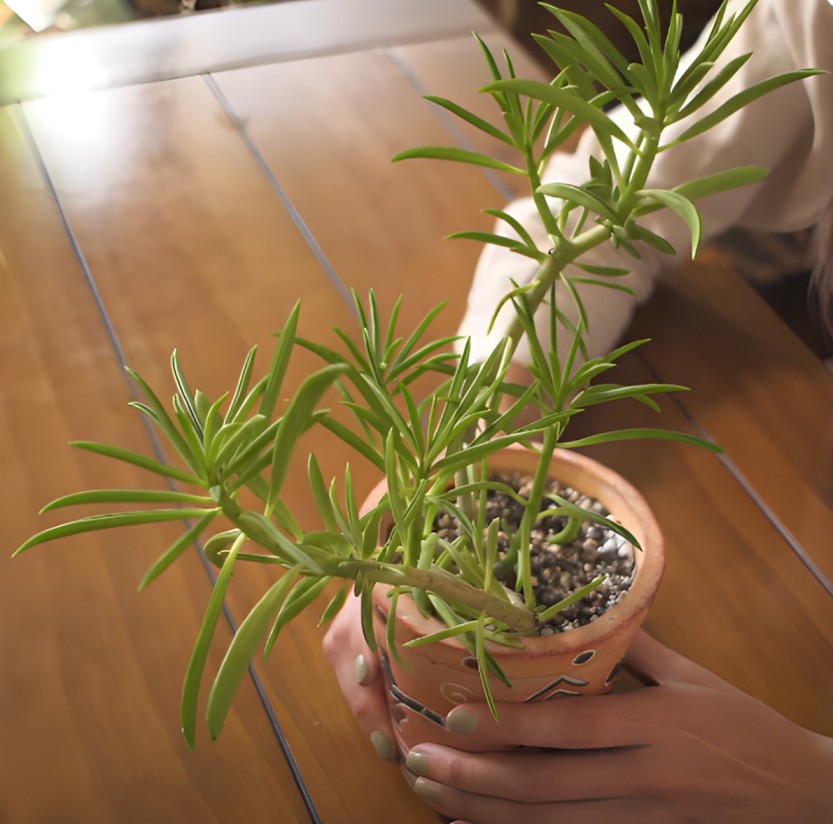
Maintenance of Pincushion Peperomia: Nurturing the ‘Happy Bean’
Taking care of a Peperomia-Ferreyrae, commonly known as the ‘happy bean,’ involves a combination of attentive practices. This plant, cherished for its distinct appearance, requires regular care and maintenance.
To ensure optimal growth, it is essential to follow a careful watering schedule, as overwatering can lead to issues such as root rot. Proper pruning techniques, outlined in the Pincushion Peperomia pflege, can help maintain its shape and prevent legginess.
Additionally, understanding the plant’s specific needs, such as those related to sunlight and soil, plays a crucial role in successful care. The ‘happy bean’ variety, along with other green peperomia-ferreyrae types, has distinctive characteristics that make them popular choices among plant enthusiasts.
Ensuring they receive the right amount of light and are watered according to their individual requirements can contribute to a healthy and thriving this plant.
Issues, and Safety: Ensuring the Well-being of Pincushion Peperomia
Propagation is another aspect of peperomia care, and enthusiasts often explore methods like Pincushion Peperomia propagation in water or using cuttings (ableger and vermehren). The process of bouture peperomia ferreyrae involves taking cuttings and encouraging them to develop roots, leading to new, independent plants.
Understanding these propagation techniques can be beneficial for plant owners looking to expand their collection or share their peperomia-ferreyrae with others. It’s important to address any potential issues promptly, such as black leaves, legginess, or yellowing, as outlined in the clusters related to issues and remedies.
Additionally, being aware of the plant’s toxicity, as discussed in the toxicity and safety cluster, ensures a safe environment for households with pets, as some peperomia varieties may be toxic to cats. Overall, mastering the care, propagation, and characteristics of Peperomia Ferreyrae enhances the enjoyment and longevity of these unique and attractive plants.
FAQs
How do you take care of Peperomia Ferreyrae?
Indirect sunshine, well-draining soil, and moderate watering—letting the soil dry between applications—are all recommended.
Does the happy bean plant flower?
Yes, but the plant’s little, greenish-white blossoms are usually seen as inconsequential in comparison to its unusual leaves.
What if my happy bean plant is too long?
To promote a more compact form and preserve the plant’s visual appeal, trim lanky growth.
What is another name for Peperomia Ferreyrae?
Peperomia Ferreyrae is commonly known as the ‘Happy Bean’ plant.
How much sun does a happy bean plant need?
Though they can withstand lower light levels, happy bean plants prefer bright, indirect light.
Why is my happy bean dropping leaves?
Stress from the environment and being submerged or overwatered can cause leaves to drop. Adapt care and watering as necessary.
How do you take cuttings from a happy bean plant?
To propagate new plants, take stem or leaf cuttings, let them dry, and then plant them in soil that drains well.
Why are the leaves on my happy bean plant turning yellow?
Yellowing leaves might be a sign of nutritional shortages, overwatering, or underwatering. Adapt care according to particular circumstances.
How do I make my happy bean plant bushier?
Pinch back the tips of the plant to promote branching and a fuller, bushier appearance when you selectively prune it.

